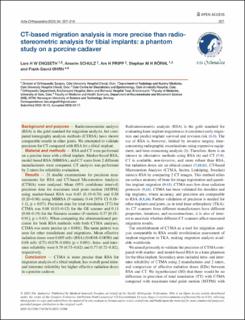| dc.contributor.author | Engseth, Lars | |
| dc.contributor.author | Schulz, Anselm | |
| dc.contributor.author | Pripp, Are Hugo | |
| dc.contributor.author | Rörhl, Stephan M. H. | |
| dc.contributor.author | Øhrn, Frank-David | |
| dc.date.accessioned | 2023-11-29T08:23:02Z | |
| dc.date.available | 2023-11-29T08:23:02Z | |
| dc.date.created | 2023-06-01T16:33:42Z | |
| dc.date.issued | 2023 | |
| dc.identifier.citation | Acta Orthopaedica. 2023, 94 207-214. | en_US |
| dc.identifier.issn | 1745-3674 | |
| dc.identifier.uri | https://hdl.handle.net/11250/3105156 | |
| dc.description.abstract | Background and purpose: Radiostereometric analysis (RSA) is the gold standard for migration analysis, but computed tomography analysis methods (CTRSA) have shown comparable results in other joints. We attempted to validate precision for CT compared with RSA for a tibial implant.
Material and methods: RSA and CT were performed on a porcine knee with a tibial implant. Marker-based RSA, model-based RSA (MBRSA), and CT scans from 2 different manufacturers were compared. CT analysis was performed by 2 raters for reliability evaluation.
Results: 21 double examinations for precision measurements for RSA and CT-based Micromotion Analysis (CTMA) were analysed. Mean (95% confidence interval) precision data for maximum total point motion (MTPM) using marker-based RSA was 0.45 (0.19–0.70) and 0.58 (0.20–0.96) using MBRSA (F-statistic 0.44 [95% CI 0.18–1.1], p = 0.07). Precision data for total translation (TT) for CTMA was 0.08 (0.03–0.12) for the GE scanner and 0.11 (0.04–0.19) for the Siemens scanner (F-statistic 0.37 [0.15–0.91], p = 0.03). When comparing the aforementioned precision for both RSA methods with both CTMA analyses, CTMA was more precise (p < 0.001). The same pattern was seen for other translations and migrations. Mean effective radiation doses were 0.005 mSv (RSA) (0.0048–0.0050) and 0.08 mSv (CT) (0.078–0.080) (p < 0.001). Intra- and interrater reliability were 0.79 (0.75–0.82) and 0.77 (0.72–0.82), respectively.
Conclusion: CTMA is more precise than RSA for migration analysis of a tibial implant, has overall good intra- and interrater reliability but higher effective radiation doses in a porcine cadaver. | en_US |
| dc.language.iso | eng | en_US |
| dc.publisher | Medical Journals Sweden AB | en_US |
| dc.rights | Navngivelse 4.0 Internasjonal | * |
| dc.rights | Navngivelse-Ikkekommersiell 4.0 Internasjonal | * |
| dc.rights.uri | http://creativecommons.org/licenses/by-nc/4.0/deed.no | * |
| dc.title | CT-based migration analysis is more precise than radio-stereometric analysis for tibial implants: a phantom study on a porcine cadaver | en_US |
| dc.title.alternative | CT-based migration analysis is more precise than radio-stereometric analysis for tibial implants: a phantom study on a porcine cadaver | en_US |
| dc.type | Peer reviewed | en_US |
| dc.type | Journal article | en_US |
| dc.description.version | publishedVersion | en_US |
| dc.source.pagenumber | 207-214 | en_US |
| dc.source.volume | 94 | en_US |
| dc.source.journal | Acta Orthopaedica | en_US |
| dc.identifier.doi | 10.2340/17453674.2023.12306 | |
| dc.identifier.cristin | 2150966 | |
| cristin.ispublished | true | |
| cristin.fulltext | original | |
| cristin.qualitycode | 1 | |

